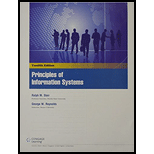
PRINCIPLES OF INFO.SYS.(LL)>CUSTOM PKG<
12th Edition
ISBN: 9781337074674
Author: STAIR
Publisher: CENGAGE C
expand_more
expand_more
format_list_bulleted
Expert Solution & Answer
Chapter 12, Problem 10RQ
Explanation of Solution
Data-flow diagram:
- A data-flow diagram (DFD) is a diagram used during both the analysis and design phases to document the processes of the current system or to provide a model of a proposed new system.
- Structure of DFD starts from a broad overview and expand it to a hierarchy of detailed diagrams
Uses:
- It shows not only the various processes within the system but also where the data needed for each process comes from, where the output of each process will be sent, and what data will be stored and where.
- The DFD does not provide any information about the process timing (e...
Expert Solution & Answer
Want to see the full answer?
Check out a sample textbook solution
Students have asked these similar questions
Create a relationship between the common field (Technician Number) of the two tables. Make sure that each client must have 1 and only 1 technician assigned, and each technician can have multiple clients.
2. Create a query to show the Client Number, Client Name, Billed, Paid for clients in Anderson city. Save the query.
3. Create a query to show the Technician Number, Last Name, First Name, YTD Earnings for technicians whose Hourly Rate is greater than or equal to 30. Save the query.
4. Create a query to show Client Number, Client Name, Billed, Paid for clients whose technician number is 22 and whose Billed is over 300. Save the query.
5. Create a query to show the Technician Number, Last Name, First Name, Client Number, Client Name for clients whose technician number 23. Save the query.
6. Create a query to show the Technician Number, Last Name, First Name, Client Number, Client Name for clients whose technician number 23 or 29. Save the query Help please Microsoft office access
Dijkstra's Algorithm (part 1). Consider the network shown below, and Dijkstra’s link-state algorithm. Here, we are interested in computing the least cost path from node E (note: the start node here is E) to all other nodes using Dijkstra's algorithm. Using the algorithm statement used in the textbook and its visual representation, complete the "Step 0" row in the table below showing the link state algorithm’s execution by matching the table entries (i), (ii), (iii), and (iv) with their values. Write down your final [correct] answer, as you‘ll need it for the next question.
4. |z + 5 - 5i| = 7
Chapter 12 Solutions
PRINCIPLES OF INFO.SYS.(LL)>CUSTOM PKG<
Ch. 12.5 - Prob. 1DQCh. 12.5 - Prob. 2DQCh. 12.5 - Prob. 1CTQCh. 12.5 - Prob. 2CTQCh. 12.8 - Prob. 1DQCh. 12.8 - Prob. 2DQCh. 12.8 - Prob. 1CTQCh. 12.8 - Prob. 2CTQCh. 12 - Prob. 1SATCh. 12 - Prob. 2SAT
Ch. 12 - Prob. 3SATCh. 12 - The ______ is a key member and the leader of the...Ch. 12 - Prob. 5SATCh. 12 - Prob. 6SATCh. 12 - Prob. 7SATCh. 12 - Prob. 8SATCh. 12 - Prob. 9SATCh. 12 - Prob. 10SATCh. 12 - Feasibility analysis is typically done during...Ch. 12 - Data modeling is most often accomplished through...Ch. 12 - Prob. 13SATCh. 12 - Prob. 14SATCh. 12 - Any potential change in system requirements that...Ch. 12 - Prob. 1RQCh. 12 - Prob. 2RQCh. 12 - Prob. 3RQCh. 12 - Prob. 4RQCh. 12 - Prob. 5RQCh. 12 - Prob. 6RQCh. 12 - Prob. 7RQCh. 12 - Prob. 8RQCh. 12 - Prob. 9RQCh. 12 - Prob. 10RQCh. 12 - Prob. 11RQCh. 12 - Prob. 12RQCh. 12 - Prob. 13RQCh. 12 - Prob. 14RQCh. 12 - Prob. 15RQCh. 12 - Prob. 16RQCh. 12 - Prob. 1DQCh. 12 - Prob. 3DQCh. 12 - Prob. 5DQCh. 12 - Prob. 6DQCh. 12 - Prob. 10DQCh. 12 - Prob. 11DQCh. 12 - Prob. 1DQ1Ch. 12 - Prob. 2DQ1Ch. 12 - Prob. 1CTQ1Ch. 12 - Prob. 2CTQ1Ch. 12 - Prob. 1DQ2Ch. 12 - Prob. 2DQ2Ch. 12 - Prob. 1CTQ2Ch. 12 - Prob. 2CTQ2Ch. 12 - Prob. 1DQ3Ch. 12 - Prob. 2DQ3Ch. 12 - Prob. 1CTQ3Ch. 12 - Prob. 2CTQ3
Knowledge Booster
Similar questions
arrow_back_ios
SEE MORE QUESTIONS
arrow_forward_ios
Recommended textbooks for you
 Systems ArchitectureComputer ScienceISBN:9781305080195Author:Stephen D. BurdPublisher:Cengage Learning
Systems ArchitectureComputer ScienceISBN:9781305080195Author:Stephen D. BurdPublisher:Cengage Learning Principles of Information Systems (MindTap Course...Computer ScienceISBN:9781305971776Author:Ralph Stair, George ReynoldsPublisher:Cengage Learning
Principles of Information Systems (MindTap Course...Computer ScienceISBN:9781305971776Author:Ralph Stair, George ReynoldsPublisher:Cengage Learning Management Of Information SecurityComputer ScienceISBN:9781337405713Author:WHITMAN, Michael.Publisher:Cengage Learning,
Management Of Information SecurityComputer ScienceISBN:9781337405713Author:WHITMAN, Michael.Publisher:Cengage Learning, Fundamentals of Information SystemsComputer ScienceISBN:9781337097536Author:Ralph Stair, George ReynoldsPublisher:Cengage Learning
Fundamentals of Information SystemsComputer ScienceISBN:9781337097536Author:Ralph Stair, George ReynoldsPublisher:Cengage Learning Principles of Information Systems (MindTap Course...Computer ScienceISBN:9781285867168Author:Ralph Stair, George ReynoldsPublisher:Cengage Learning
Principles of Information Systems (MindTap Course...Computer ScienceISBN:9781285867168Author:Ralph Stair, George ReynoldsPublisher:Cengage Learning

Systems Architecture
Computer Science
ISBN:9781305080195
Author:Stephen D. Burd
Publisher:Cengage Learning


Principles of Information Systems (MindTap Course...
Computer Science
ISBN:9781305971776
Author:Ralph Stair, George Reynolds
Publisher:Cengage Learning

Management Of Information Security
Computer Science
ISBN:9781337405713
Author:WHITMAN, Michael.
Publisher:Cengage Learning,

Fundamentals of Information Systems
Computer Science
ISBN:9781337097536
Author:Ralph Stair, George Reynolds
Publisher:Cengage Learning

Principles of Information Systems (MindTap Course...
Computer Science
ISBN:9781285867168
Author:Ralph Stair, George Reynolds
Publisher:Cengage Learning